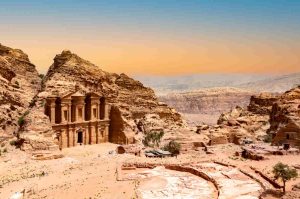For all history buffs, there is one period of the past that holds a special attraction: the Greco-Roman world. If this is your case, Mandala Tours can make your dream come true, but with a twist: visiting destinations of great interest that, paradoxically, are neither in Greece nor in Italy. Here are the places we can take you to, located in the Middle East and North Africa.
Ancient Greece… in Turkey
What is known as ‘Ancient Greece’ actually encompasses many places outside of present-day Greece. In particular, some of the most spectacular sites are on the Anatolian Peninsula, which now belongs to Turkey. Above all, on its Aegean coast, but not only. Here is a list of some of those places, something that will surely surprise you:
- Troy: this city, between mythical and real because of its famous war, is located on the current hill of Hisarlik (Çanakkale province). Its archaeological remains are not the most spectacular, but its fame and symbolism will delight lovers of Ancient Greece. By the way: this war was narrated in the Iliad by Homer, a writer who, according to some sources, may have been born in Smyrna.
- Ephesus: is probably one of the best preserved Greek cities in present-day Turkey. Among its attractions are the Temple of Artemis, the Theater, the Avenue of Curetes, the Library of Celsus and the Temple of Hadrian, the latter two dating back to the Roman era.
- Pergamon: although it suffered important heritage losses (like a large part of its altar, now in Berlin), its acropolis still retains the charm of what was once that great city.
- Hierapolis: as we indicated in this other post, its fame is due in part to its spectacular thermal springs(Pamukkale), but this cannot eclipse the richness of the remains that are still preserved, mainly those of the reconstruction of the city in Roman times, carried out in the II-III centuries.
Halicarnassus, Miletus or Smyrna are other places of enormous Greco-Roman imprint, something that can also be seen in mythology, with characters located here as famous as Midas, King of Phrygia.
Jordan and Israel, Decapolis territory and more
The Roman Empire reached an even wider territorial extension than its predecessors, the Greeks. Its eastern limits reached approximately to present-day Syria and Jordan, and the emperor Hadrian, who traveled here, gave a good account of this. Therefore, in our travels through Jordan and Israel you can discover very well preserved destinations, with Roman forums, aqueducts, theaters … and much more. Amman is an example of this, but even more evident is the spectacular Jerash or the Israeli port city of Caesarea.
Ptolemaic and Greco-Roman Egypt
Long after the splendor of the pharaohs who erected the Pyramids of Giza or excavated the Valley of the Kings at Luxor, Ancient Egypt was dominated by dynasties and rulers of Greco-Roman lineage. The Ptolemaic dynasty, to which Cleopatra belonged, stands out: although many Egyptian temples were built to gain the fervor of the people, they also left their more Hellenizing stamp on cities such as Alexandria. For their part, the Roman rulers (from the time of Emperor Octavian Augustus onwards) left less of an imprint in the form of monuments and cities, but with them germinated the seed of Coptic Christianity, persecuted at the beginning and protected later.
Morocco, another limit for the Romans
Despite its remoteness from Rome, the territory of northern Morocco was also a Roman province (Mauritana Tingitana), and some vestiges of that period have been preserved. Volubilis, its capital, stands out, with an archaeological site where you can see mosaics, colonnades of ancient temples and even an arch, from the time of Caracalla. In addition, in the surroundings of Tangier are located the Caves of Hercules, this Greco-Roman hero who came here to perform some of his mythical works.





